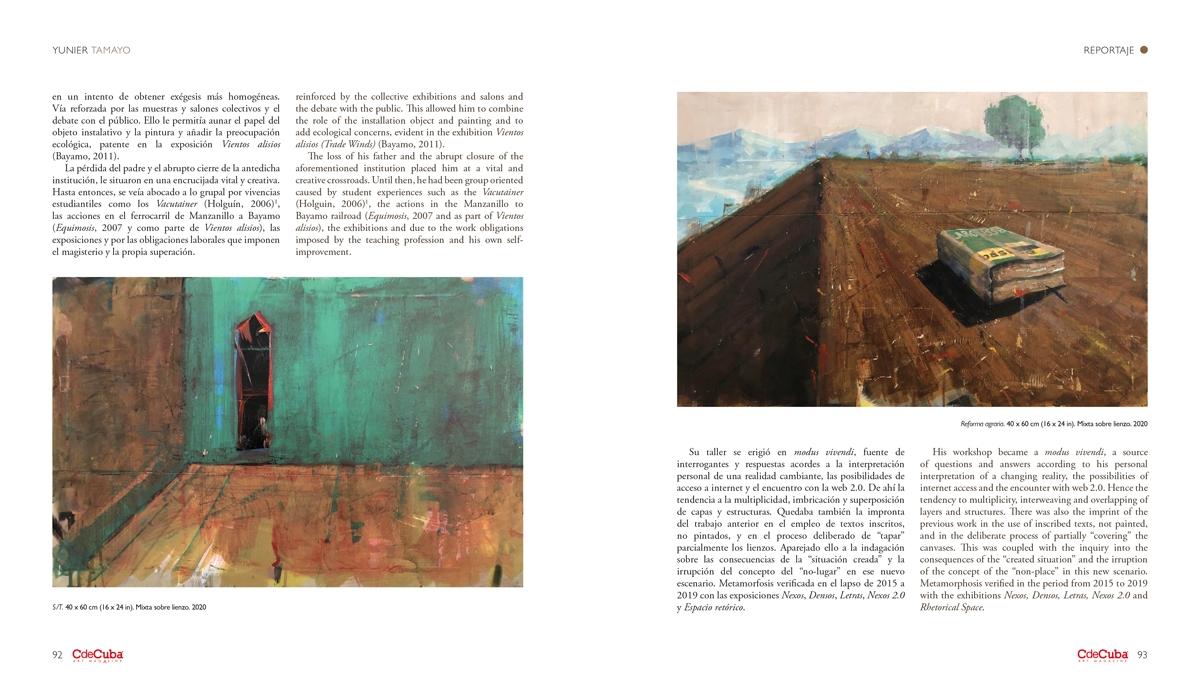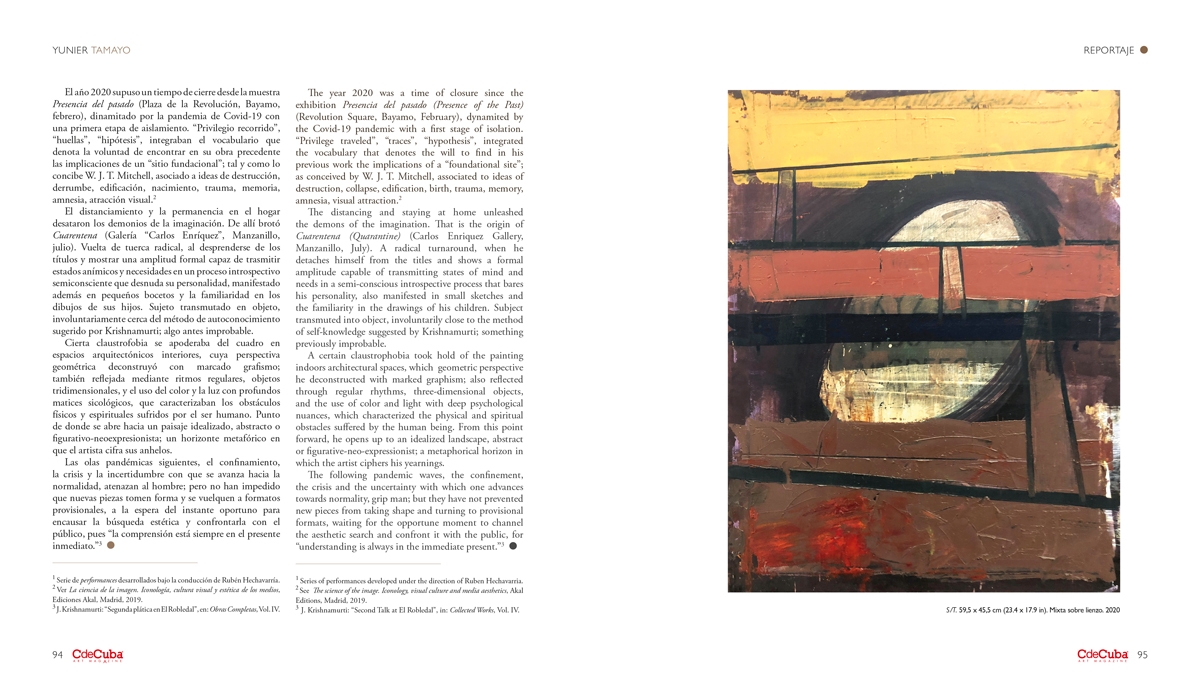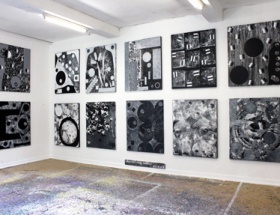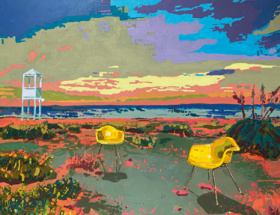Untitled
By Carlos R. Escala Fernandez
The world is everything that happens.
Ludwig Wittgenstein (Tractatus Logico-Philosophicus)
The only certainty for Yunier Tamayo Sánchez (Manzanillo, Cuba, 1983) is the Socratic doubt that drives the artistic process, linked to his existence, and that leads him to the evolution of a multiform and highly crafted work. Characterized by the pragmatism and ductility to translate the findings of a stage or formal practice to another, and even lead himself through different channels simultaneously, due to the fact that the circumstances and the will coexist in a fickle balance, exploited to its ultimate consequences.
Tamayo’s career spans almost two decades. Installation, performance, happening, were vehicles of experimentation of situationist conceptions, in the context in which his trips to study in Holguín influenced his sociological and aesthetic perception of the world, with special contribution of the teachings of Ruben Hechavarria Salvia, Ernesto Blanco Sanciprian and Lizzet Riquelme, among others, in the Professional Academy of Plastic Arts “El Alba”.
This theoretical-practical impulse gradually turned to the canvas in two fundamental aspects, human relations and language; transposed to a symbolic-abstract system with pop elements, in which pigments, text and daily signage coexisted in colorful atmospheres that gave his pieces a sense of baroque associated with the interaction of crowds.
His praxis at the “Carlos Enriquez” Academy added concerns that went beyond the participant observation of a social fact, to be linked to the theoretical-artistic and pedagogical discussion and to assume the role of message builder and arbiter in the reactions of his receivers and students. The “verbal supplements” dominated the shape from the title and integrated into the composition, in an attempt to obtain more homogeneous exegeses. Method reinforced by the collective exhibitions and salons and the debate with the public. This allowed him to combine the role of the installation object and painting and to add ecological concerns, evident in the exhibition Vientos alisios (Trade Winds) (Bayamo, 2011).
The loss of his father and the abrupt closure of the aforementioned institution placed him at a vital and creative crossroads. Until then, he had been group oriented caused by student experiences such as the Vacutainer (Holguin, 2006)1, the actions in the Manzanillo to Bayamo railroad (Equimosis, 2007 and as part of Vientos alisios), the exhibitions and due to the work obligations imposed by the teaching profession and his own self-improvement.
His workshop became a modus vivendi, a source of questions and answers according to his personal interpretation of a changing reality, the possibilities of internet access and the encounter with web 2.0. Hence the tendency to multiplicity, interweaving and overlapping of layers and structures. There was also the imprint of the previous work in the use of inscribed texts, not painted, and in the deliberate process of partially “covering” the canvases. This was coupled with the inquiry into the consequences of the “created situation” and the irruption of the concept of the “non-place” in this new scenario. Metamorphosis verified in the period from 2015 to 2019 with the exhibitions Nexos, Densos, Letras, Nexos 2.0 and Rhetorical Space.
The year 2020 was a time of closure since the exhibition Presencia del pasado (Presence of the Past) (Revolution Square, Bayamo, February), dynamited by the Covid-19 pandemic with a first stage of isolation. “Privilege traveled”, “traces”, “hypothesis”, integrated the vocabulary that denotes the will to find in his previous work the implications of a “foundational site”; as conceived by W. J. T. Mitchell, associated to ideas of destruction, collapse, edification, birth, trauma, memory, amnesia, visual attraction.2
The distancing and staying at home unleashed the demons of the imagination. That is the origin of Cuarentena (Quarantine) (Carlos Enriquez Gallery, Manzanillo, July). A radical turnaround, when he detaches himself from the titles and shows a formal amplitude capable of transmitting states of mind and needs in a semi-conscious introspective process that bares his personality, also manifested in small sketches and the familiarity in the drawings of his children. Subject transmuted into object, involuntarily close to the method of self-knowledge suggested by Krishnamurti; something previously improbable.
A certain claustrophobia took hold of the painting indoors architectural spaces, which geometric perspective he deconstructed with marked graphism; also reflected through regular rhythms, three-dimensional objects, and the use of color and light with deep psychological nuances, which characterized the physical and spiritual obstacles suffered by the human being. From this point forward, he opens up to an idealized landscape, abstract or figurative-neo-expressionist; a metaphorical horizon in which the artist ciphers his yearnings.
The following pandemic waves, the confinement, the crisis and the uncertainty with which one advances towards normality, grip man; but they have not prevented new pieces from taking shape and turning to provisional formats, waiting for the opportune moment to channel the aesthetic search and confront it with the public, for “understanding is always in the immediate present.”3
1. Series of performances developed under the direction of Ruben Hechavarria.
2. See The science of the image. Iconology, visual culture and media aesthetics, Akal Editions, Madrid, 2019.
3. J. Krishnamurti: “Second Talk at El Robledal”, in: Collected Works, Vol. IV.






